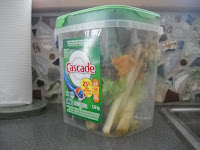In
early spring my Dad would take the whole family into the woods in search of the
native Pussy Willow (Salix discolor). This was a great adventure for us and we
never came home empty handed. I fondly remember stroking the fuzzy catkins — soft
as a kitten — lining the stems. This memory came back to me in March at a
landscape conference I attended. I was offered pussy willow branches that were on display arranged
in containers to take home. I was assured by the UNH Cooperative Extension
staff that they were very easy to root so I decided to give it a shot!
I
put the willow branches in a maple syrup bucket filled with water by my front
door. It was a lovely accent while waiting patiently to see if they would grow roots.
Coincidentally, I did find potted Pussy Willows at my local supermarket which I
purchased and planted, just in case I was unsuccessful with my efforts.
It
was many weeks later that I noticed the buds breaking and soft green leaves emerging. Most of the branches had grown roots. I planted
the rooting branches in various locations throughout my landscape.
Although normally found in sunny wet areas,
UNH has been growing them successfully in dryer locations. I am hoping(fingers crossed) to get them established and eventually
find a home for them in one of my projects. If you don’t have the resources and
time to root cuttings, look for container plants at your local garden center or
online.
 The
Pussy Willow and Black Willow (Salix nigra) are a great addition to any
landscape as they are important pollinator plants. Blooming at a time when much
of the garden is still asleep, these woody plants provide nectar and/or pollen
before much else is available. Nectar is the primary energy source for bees,
while pollen provides the protein essential to brood rearing and the
development of young bees. They are also host plants for Mourning Cloak and
Viceroy Butterflies. Consider adding some willows to your landscape whether it
is for children or pollinators!
The
Pussy Willow and Black Willow (Salix nigra) are a great addition to any
landscape as they are important pollinator plants. Blooming at a time when much
of the garden is still asleep, these woody plants provide nectar and/or pollen
before much else is available. Nectar is the primary energy source for bees,
while pollen provides the protein essential to brood rearing and the
development of young bees. They are also host plants for Mourning Cloak and
Viceroy Butterflies. Consider adding some willows to your landscape whether it
is for children or pollinators!




























